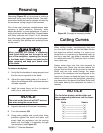
-32-
G0636X 17" Ultimate Bandsaw
Crosscutting is the process of cutting across the
grain of wood. For plywood and other processed
wood, crosscutting simply means cutting across
the width of the material.
To make a 90˚ crosscut:
1. Mark the workpiece on the edge where you
want to begin the cut.
2. Adjust the blade guide assembly to the cor-
rect height and make sure the miter gauge is
set to 0°.
3. Move the fence out of the way. Place the
workpiece evenly against the miter gauge.
4. Hold the workpiece against the miter gauge
and line up the mark with the blade.
5. After all safety precautions have been met,
turn the bandsaw ON. Slowly feed the
workpiece into the blade and continue the
cut until the blade is all the way through the
workpiece. Figure 44 shows a typical cross-
cutting operation.
Figure 44. Example of crosscutting operation
with miter gauge.
Ripping is the process of cutting with the grain
of the wood stock. For plywood and other pro-
cessed wood, ripping simply means cutting down
the length of the workpiece. For ripping, a wider
blade is better. In most ripping applications, a
standard raker tooth style will be sufficient.
To make a rip cut:
1. Adjust the fence to match the width of the
cut on your workpiece and lock the fence in
place.
2. Adjust the blade guide assembly to the cor-
rect height.
3. After all safety precautions have been met,
turn the bandsaw ON. Slowly feed the
workpiece into the blade and continue with
the cut until the blade is completely through
the workpiece.
Figure 43 shows a typical rip-
ping operation.
Note: If you are cutting nar-
row pieces, use a push stick to protect your
fingers.
Figure 43. Example of typical ripping operation
with a push stick.
NEVER place fingers or hands in the line of
cut. In the event that something unexpected
happens, your hands or fingers may slip
into the blade. ALWAYS use a push stick
when ripping narrow pieces. Failure to fol
-
low these warnings may result in serious
personal injury!
Ripping Crosscutting


















